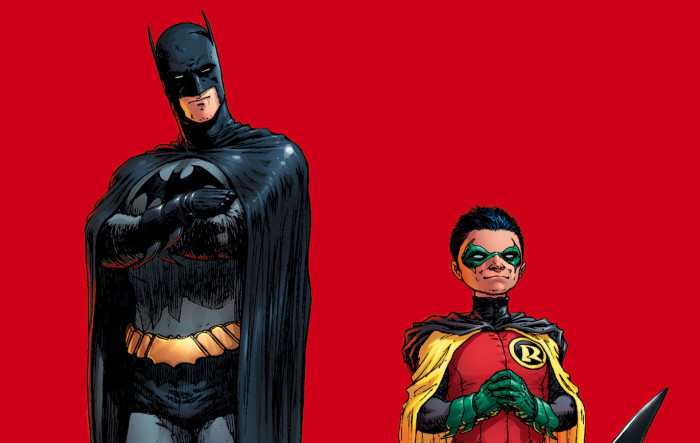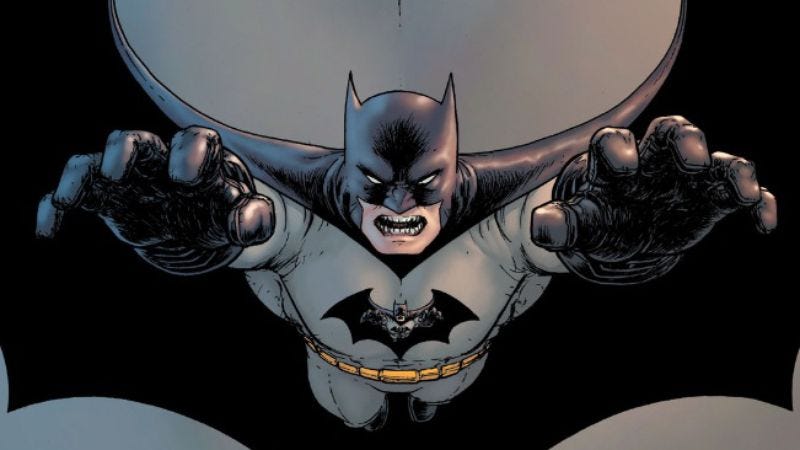"Batman always comes back, bigger and better, shiny and new. Batman never dies. It never ends. It probably never will." But if there ever was an ultimate Batman story, this would be it. Grant Morrison's legendary Batman saga ties all facets of the beloved Caped Crusader into a single tale, producing a piece of modern-day mythology that will define Gotham's protector for generations.
Morrison's Batman tale ran for seven years in total, but its many nods to Gotham's past and hints towards its future make it feel like a comprehensive record of the Wayne legacy. When writing this epic, Morrison declared that all prior Batman stories did indeed happen, with his run being the focal point of them all.
The adventure begins in Batman and Son, which throws us straight into the madness with a scene of a trigger-happy Batman attempting to kill the Joker, only to be stopped by...Batman? This introduces us to a central theme of the series: the bat used as a symbol by many, rather than just the guise of one man.
Later on in this first volume, readers (and Batman) meet Damian Wayne, Bruce's ten-year-old son. This obnoxious and violent little brat goes on to become one of the most compelling and well-rounded DC Comics characters ever created, with most of Morrison's run revolving around a war between his father and his criminal mastermind mother, Talia al Ghul.
Talia is far from the only one with a grudge against the Dark Knight, however. One of Morrison's most genius additions to the Batman mythos is the Black Glove, a secret society responsible for the events of the second volume, R.I.P. No story has ever delved as deeply into the mind of Bruce Wayne as this, and very few have ever harmed him this much.
These first two stories are brought to life by artists Andy Kubert, J.H. Williams III and Tony S. Daniel. Their art is sleek, slick and realistic, seamlessly weaving the feel of the Burton and Nolan films into a piece of art worthy of a live-action adaptation.
R.I.P. leads into what can honestly be called the most large-scale piece of superhero fiction that will ever be produced. Final Crisis, while inextricably linked to the Batman books that surround it, is a story worthy of its own review. It pits all of DC's heroes against Darkseid, an evil god who has succeeded in extending his reign of terror and darkness over all of reality.
In Final Crisis, we see conflicts of unparalleled magnitude unfold. Time-travelling bullets tear back and forth through reality. Miraculous machines rewrite the story as you read it. Characters reach out of the very pages in a plea for divine intervention. As you might expect, this book often receives criticism for being a little too much to take in - don't let the paradoxes drive you crazy and you might find your new favourite story.
The main addition Final Crisis makes to the Batman saga is subtracting Bruce Wayne. The hero of seven decades worth of preceding comics finally meets his match when he comes face-to-face with Darkseid, meaning a new hero must take up the cape and cowl. So, who is worthy of being the Batman of the next generation?
In the paradigm-shattering Batman Reborn, along with frequent collaborator Frank Quitely, Morrison establishes Dick Grayson and Damian Wayne as the new Batman and Robin. Everything about this adventure is fresh and new, from the brilliant dynamic between the two heroes to the beautifully innovative action sequences - Morrison and Quitely's attempt to completely reinvent the world of Batman cannot be praised enough.
Unfortunately, Quitely is only able to stick around for the beginning of the Batman and Robin arc due to the sheer level of detail in his artwork (he does continue to provide cover art, however). Philip Tan illustrates the next story, in which we see our new Batman contrasted with his mirror image: the Red Hood. Tan's art is more similar in feel to that of Batman and Son and R.I.P., demonstrating that the differences between Bruce and Dick persist no matter who is drawing them.
The next volume, Batman vs. Robin, returns to an art style similar to Quitely's, perhaps best described as "neo-Silver Age". Dick and Damian's world is brimming with crazy new characters and mysteries, but it begins to become clear that their days as the dynamic duo are numbered, as the true nature of Bruce Wayne's death is made clear.
This fresh take on the Batman mythos could have ran for a lot longer - Morrison himself said he would've kept it going for at least five years. Nonetheless, it all converges in the amazing Batman and Robin Must Die!, which kicks off the final act of the series: Batman Incorporated.
With Batman Incorporated, we see yet another shift in tone, this time to that a Bond-esque spy thriller. Once again, Morrison revolutionises the Batman franchise by turning the now-returned Bruce Wayne's war on crime global. The beginning of the end follows Batman as he recruits crime-fighters from around the world. Some of these are obscure existing characters and others are brand new, but Batman Incorporated truly feels like a crossover of comics from different countries.
DC actually rebooted their entire line of comics whilst Batman Incorporated was running, but luckily all of Morrison's saga remained in continuity and was allowed to continue. Demon Star, the first story after the reboot, ties all previous plot points together as the international terrorist group Leviathan prepares to strike the killing blow to Gotham City. Along with its sequel, the book is illustrated by Chris Burnham, who accurately emulates Quitely's style to set the tone for the grand finale.
Morrison's phenomenal Batman run ends with Gotham's Most Wanted. For a lot of runs, writers tend to tell the stories they've always wanted to, add some elements to the canon and then put the toys back in the box, ready for a new creative team. The last volume of this run, however, leaves a huge bat-shaped scar on both the Batman franchise and the readers' hearts.
Batman has never before been backed into a corner like he is in Gotham's Most Wanted - not when Jason Todd died, not when Bane attacked and not even when he was killed in Final Crisis. The very idea of Batman is shaken to its core in these final chapters, and no writer will ever completely undo the effects.
The story of Batman doesn't end with this run - in fact, Morrison intentionally leaves the story open-ended so that many more incredible stories can spin out of it. Batman never dies. It never ends. It probably never will.
Rating: 10/10
Grant Morrison's Batman run encompasses several books. You can start with Batman and Son on Comixology or buy the new hardback omnibus editions. It is advised that you become familiar with Batman's history prior to reading this run.










Comments
Post a Comment